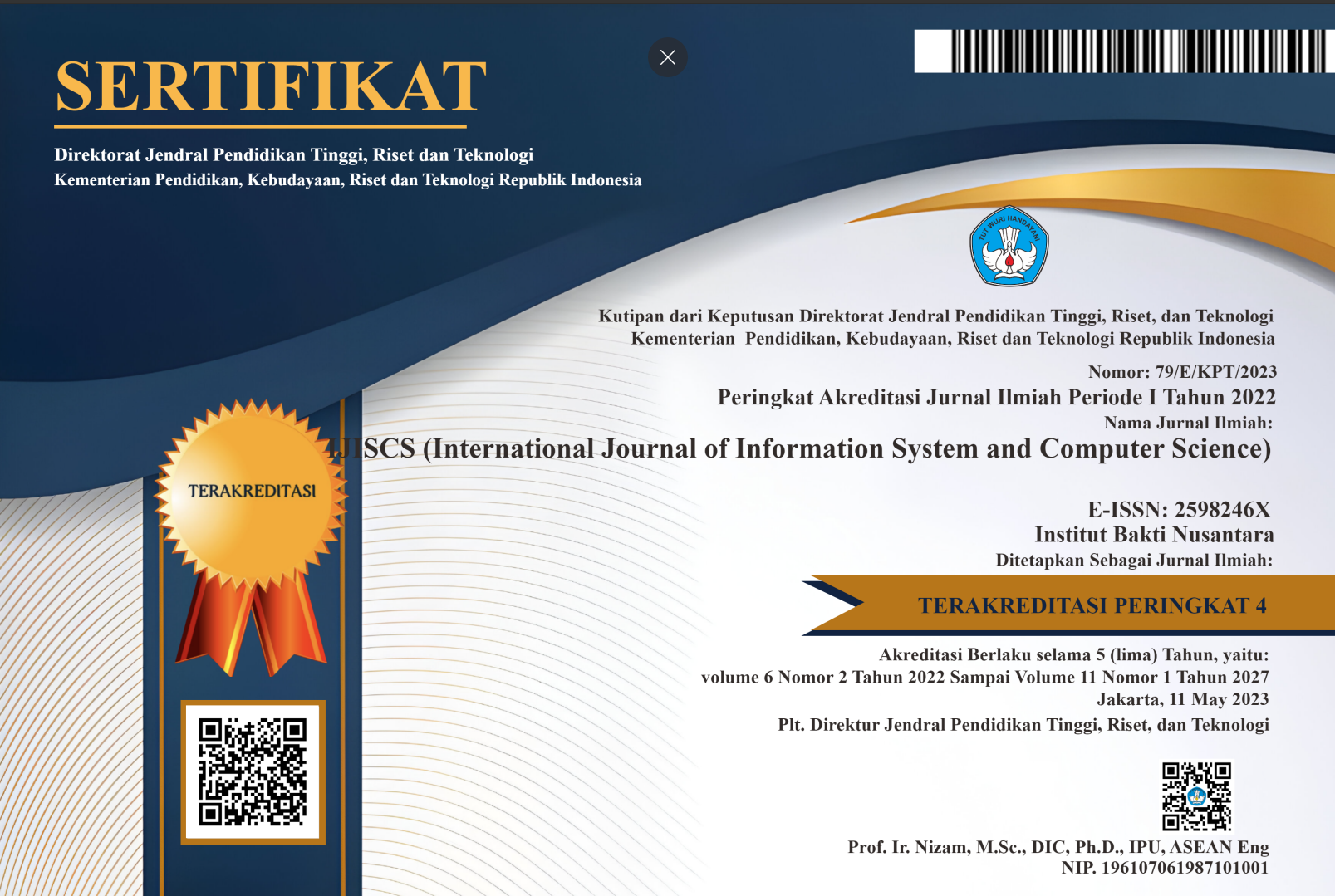A HYBRID ARIMA-MLP ALGORITHM USING ARIMA AND MLP TO IMPROVE ESTIMATION MODEL PERFORMANCE IN SOLAR RADIATION SENSOR DATA
(1) Badan Meteorologi Klimatologi dan Geofisika, Universitas Teknologi Yogyakarta
(2) Universitas Teknologi Yogyakarta
(3) Universitas Teknologi Yogyakarta
 Corresponding Author
Corresponding Author
Abstract
Keywords
References
S. Oyelami, S. 1 Oyelami, N. A. Azeez, S. A. Adedigba, O. J. Akinola, and R. M. Ajayi, “A Pyranometer for Solar Radiation Measurement-Review,” Adeleke Univ. J. Eng. Technol., vol. 3, no. 1, pp. 61–68, 2020, [Online]. Available: https://www.researchgate.net/publication/349210517
K. C. Ho, B. H. Lim, and A. C. Lai, “Recovery of the Solar Irradiance Data using Artificial Neural Network,” in IOP Conference Series: Earth and Environmental Science, IOP Publishing Ltd, Apr. 2021. doi: 10.1088/1755-1315/721/1/012006.
A. Forstinger et al., “Expert quality control of solar radiation ground data sets,” in Proceedings - ISES Solar World Congress 2021, International Solar Energy Society, 2021, pp. 1037–1048. doi: 10.18086/swc.2021.38.02.
S. Gupta et al., “Estimation of Solar Radiation with Consideration of Terrestrial Losses at a Selected Location—A Review,” Sustainability (Switzerland), vol. 15, no. 13. Multidisciplinary Digital Publishing Institute (MDPI), Jul. 01, 2023. doi: 10.3390/su15139962.
G. Chhabra, J. Ranjan, and V. Vashisht, “A Review on Missing Data Value Estimation Using Imputation Algorithm,” 2019. [Online]. Available: https://www.researchgate.net/publication/334695903
M. Bayray et al., “Temporal and spatial solar resource variation by analysis of measured irradiance in Geba catchment, North Ethiopia,” Sustain. Energy Technol. Assessments, vol. 44, Apr. 2021, doi: 10.1016/j.seta.2021.101110.
Z. Gao, W. Cheng, X. Qiu, and L. Meng, “A Missing Sensor Data Estimation Algorithm Based on Temporal and Spatial Correlation,” Int. J. Distrib. Sens. Networks, vol. 2015, 2015, doi: 10.1155/2015/435391.
E. Chodakowska, J. Nazarko, Ł. Nazarko, H. S. Rabayah, R. M. Abendeh, and R. Alawneh, “ARIMA Models in Solar Radiation Forecasting in Different Geographic Locations,” Energies, vol. 16, no. 13, Jul. 2023, doi: 10.3390/en16135029.
Enung, H. Kasyanto, R. R. Sari, and M. F. Lubis, “Application of Multilayer Perceptron (MLP) Method for Streamflow Forecasting (Case Study: Upper Citarum River, Indonesia),” in IOP Conference Series: Earth and Environmental Science, Institute of Physics, 2023. doi: 10.1088/1755-1315/1203/1/012032.
M. Khashei and Z. Hajirahimi, “A Comparative Study of Series ARIMA/MLP Hybrid Models for Stock Price Forecasting,” Commun. Stat. - Simul. Comput., vol. 48, no. 9, pp. 2625–2640, Oct. 2019, doi: 10.1080/03610918.2018.1458138.
M. Qureshi, M. Daniyal, and K. Tawiah, “Comparative Evaluation of the Multilayer Perceptron Approach with Conventional ARIMA in Modeling and Prediction of COVID-19 Daily Death Cases,” J. Healthc. Eng., vol. 2022, 2022, doi: 10.1155/2022/4864920.
WMO, Guide to Climatological Practices 2018 edition, no. WMO-No. 100. 2018.
S. Nayfach, A. P. Camargo, F. Schulz, E. Eloe-Fadrosh, S. Roux, and N. C. Kyrpides, “CheckV assesses the quality and completeness of metagenome-assembled viral genomes,” Nat. Biotechnol., vol. 39, no. 5, pp. 578–585, 2021, doi: 10.1038/s41587-020-00774-7.
S. Good et al., “Benchmarking of automatic quality control checks for ocean temperature profiles and recommendations for optimal sets,” Front. Mar. Sci., vol. 9, no. February, pp. 1–25, 2023, doi: 10.3389/fmars.2022.1075510.
Kedeputian Bidang Inskalrekjarkom, “INOVASI,” BMKG, Jakarta, 2022.
J. Wang, T. Ji, and M. Li, “A combined short-term forecast model of wind power based on empirical mode decomposition and augmented dickey-fuller test,” J. Phys. Conf. Ser., vol. 2022, no. 1, 2021, doi: 10.1088/1742-6596/2022/1/012017.
G. M. Tinungki, “The analysis of partial autocorrelation function in predicting maximum wind speed,” IOP Conf. Ser. Earth Environ. Sci., vol. 235, no. 1, 2019, doi: 10.1088/1755-1315/235/1/012097.
U. A. Yakubu and M. P. A. Saputra, “Time Series Model Analysis Using Autocorrelation Function (ACF) and Partial Autocorrelation Function (PACF) for E-wallet Transactions during a Pandemic,” Int. J. Glob. Oper. Res., vol. 3, no. 3, pp. 80–85, 2022, doi: 10.47194/ijgor.v3i3.168.
I. Syahrini, R. Radhiah, W. F. Damanik, N. Sciences, U. S. Kuala, and B. Aceh, “Application of the Autoregressive Integrated Moving Average (ARIMA) Box-Jenkins Method in Forecasting Inflation Rate in Aceh,” Transcendent J. Math. Appl. ISSN, vol. 2, no. 1, pp. 27–33, 2023.
H. S. Wicaksana et al., “Air Temperature Sensor Estimation on Automatic Weather Station Using ARIMA and MLP,” vol. 14, no. 2, 2022.
V. Rajalakshmi and S. G. Vaidyanathan, “Hybrid Time-Series Forecasting Models for Traffic Flow Prediction,” Promet - Traffic - Traffico, vol. 34, no. 4, pp. 537–549, 2022, doi: 10.7307/ptt.v34i4.3998.
D. Chicco, M. J. Warrens, and G. Jurman, “The coefficient of determination R-squared is more informative than SMAPE, MAE, MAPE, MSE and RMSE in regression analysis evaluation,” PeerJ Comput. Sci., vol. 7, pp. 1–24, 2021, doi: 10.7717/PEERJ-CS.623.
P. S. Saketh, R. Rohit, and B. Suneetha, “Weather Forecasting using Machine Learning,” 6th Int. Conf. Inven. Comput. Technol. ICICT 2023 - Proc., pp. 13–18, 2023, doi: 10.1109/ICICT57646.2023.10134218.
Article Metrics
Abstract View : 605 times
: 605 times Download : 213 times
Download : 213 times
DOI: 10.56327/ijiscs.v7i3.1617
Refbacks
- There are currently no refbacks.






